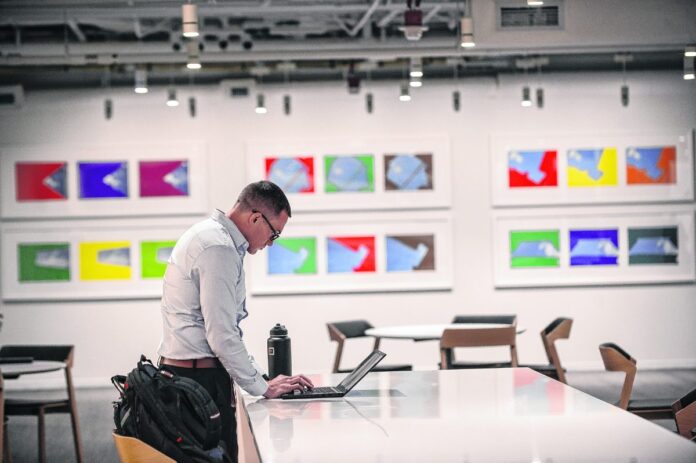
It has been nearly a year since Cummins workers filled offices in downtown Columbus and frequented nearby businesses — and there’s still no timetable for when or how many will return or what their work arrangements will be like once they do.
Currently, Cummins is evaluating what its “new normal” will look like, including the possibility of some positions remaining fully remote. The company is categorizing each role in the company as fully on-site, fully remote or a hybrid between the two based on the nature of the work, “with the majority of roles being hybrid,” said Cummins spokesman Jon Mills.
“I think we will be sending (people) back, just how many and when exactly and how we do it is still being kind of evaluated,” Mills said.
Cummins employs about 8,000 people in the Columbus area and has several offices downtown, including its corporate headquarters. Those buildings can accommodate around 1,000 workers.
[sc:text-divider text-divider-title=”Story continues below gallery” ]
Before the pandemic, downtown Columbus was bursting with workers, who would pour out of their offices and into nearby restaurants during their lunch breaks, pop into retailers along Washington Street, file into fitness centers to take yoga and spinning classes and grab drinks at local bars after work.
But since the coronavirus swept across the state and community, downtown Columbus has grown much quieter, and whatever Cummins decides to do will have major implications for downtown businesses that have relied for years on foot traffic from workers and have fallen on hard times since the pandemic hit.
Despite the uncertainty surrounding workers returning to the office, Mills said Cummins remains “absolutely committed” to the vibrancy of downtown Columbus.
“We’re absolutely committed to downtown Columbus and want to make sure we do our part to make it thrive,” Mills said. “…We understand how important our presence is to downtown Columbus, and we want to do everything to contribute to the economic and social vibrancy of Columbus, but we’ve got to make sure we do it in the right way for everybody.”
As more and more people get vaccinated against COVID-19, corporate leaders across the country are grappling with how and when to send workers back to the office, if at all.
Experts say the pandemic has normalized remote work, which could continue to be a trend even after it is safe to return to the office.
The survey shows…
Recent surveys show that most businesses in the U.S. believe the massive shift to remote work is largely here to stay, with very few companies, just over 1 in 10, expecting all their remote employees to return to their pre-pandemic work arrangements, according to a January survey by the National Association of Business Economics.
Another survey done last year by S&P Global Market Intelligence found that two-thirds of companies expect work-from-home policies due to the pandemic to “remain in place either permanently or for the long-term.”
Global Workplace Analytics, a research and consulting firm that studies emerging workplace strategies, estimates that 25% to 30% of the U.S. workforce will be working remotely, at least part time, by the end of the year.
Earlier this month, Salesforce, which employs about 2,100 in Indianapolis, announced that all of its workers would have the option to continue working remotely full-time even after the pandemic subsides.
Last year, Twitter announced plans to let employees work from home indefinitely, and Facebook, which employs about 48,000 people, said half of its workforce may be permanently working remotely by the end of the decade.
Last week, after the Bartholomew Consolidated School Corp. school board approved a new virtual education director position for the school corporation, Nicole Wheeldon, a BCSC school board member and plant manager at Cummins, said she expected changes to work arrangements in her industry.
“I work in an industry where they say that someday, when we get back to some new normal, they think about a third of us will be working fully virtually, a third of us will have a hybrid, and a third of us will be in the office every day,” Wheeling said.
Now, a year after the pandemic upended traditional work environments, some communities and states are already betting big on attracting remote workers, offering financial incentives to those who are no longer tethered to the communities their employers are based in.
Currently, Indiana lawmakers are considering legislation that would set up a grant program to pay remote workers $5,000 to $8,500, depending on their salaries, to relocate to the Hoosier state.
New challenges
Cindy Frey, president of the Columbus-Area Chamber of Commerce, said she doesn’t think offices are entirely going away, but the new normal will likely pose some challenges to the community but also offer some potential benefits.
“It’s a double-sided coin,” Frey said. “The question of remote work can be a boost to the community because those who live in maybe more densely populated areas who want to get away from the high prices and the traffic and the crime and living in a small space might find a place like Columbus really appealing. On the flip side, some of the talent that’s here might choose to live somewhere else.”
Columbus Mayor Jim Lienhoop said he is concerned about what the new normal might mean for downtown Columbus and the city as a whole, but said it might “work to our advantage” in some ways.
“It could affect us in a number of different ways,” Lienhoop said. “We don’t know the extent to which people might live elsewhere. The city of Columbus has always benefited from being a headquarters-type community, and so if that changes, we’ll just have to try to assess the change. But it may also work to our advantage that people who felt like they had to live in Indianapolis or had to live in Cincinnati or some other larger community and they find it attractive to be here. So I don’t know that we should automatically think that it’s going to be negative for us. There will undoubtedly be some positives.”
The absence of workers also has raised questions about the future of downtown Columbus and plans to further develop the area, including a proposed hotel and conference center and other projects.
“Our plans involve third parties, whether they’re developers like Clarion Collins or hotel developers like Sprague and Marriott,” Lienhoop said. “So we’re pretty attuned to their view of what Cummins might do. And it’s not just Cummins. There are other employers as well that not only affect what goes on downtown, but throughout the city of Columbus. And so we will wait to hear what kind of decisions Cummins might make and then we’ll obviously discuss that with our third-party partners.”
Local officials, including Lienhoop, say the evolving landscape of work arrangements “points to the need for us to continue to make Columbus to be an attractive place” to retain workers who are already in the city and attract more.
Frey said the post-pandemic new normal will likely place more importance on projects such as the FairOaks Mall, the riverfront, affordable housing and other efforts that aim to increase the quality of life in the city.
“As a community, I think it’s increasingly important that we make investments in those projects that create the highest quality of life possible,” Frey said. “…Those investments are going to be more important than they were pre-pandemic.”
Though it is still not known what kinds of impact the pandemic will leave on downtown Columbus and the business community, Lienhoop said he is still optimistic about the city’s future.
“We expect (the new normal) to be a significant change, and change is always concerning,” Lienhoop said. “I mean, there’s always a lot of anxiety. Typically, the anxiety is that you can’t see how it’s going to work out. You just don’t know, so you become anxious. But my experience down through the years is that things have a way of working out, and we just have anxiety because we can’t see how that will be. But I’m confident that Columbus is well-positioned for whatever future may come our way.”
[sc:pullout-title pullout-title=”To learn more” ][sc:pullout-text-begin]
For more information about Cummins, visit cummins.com.
[sc:pullout-text-end]




